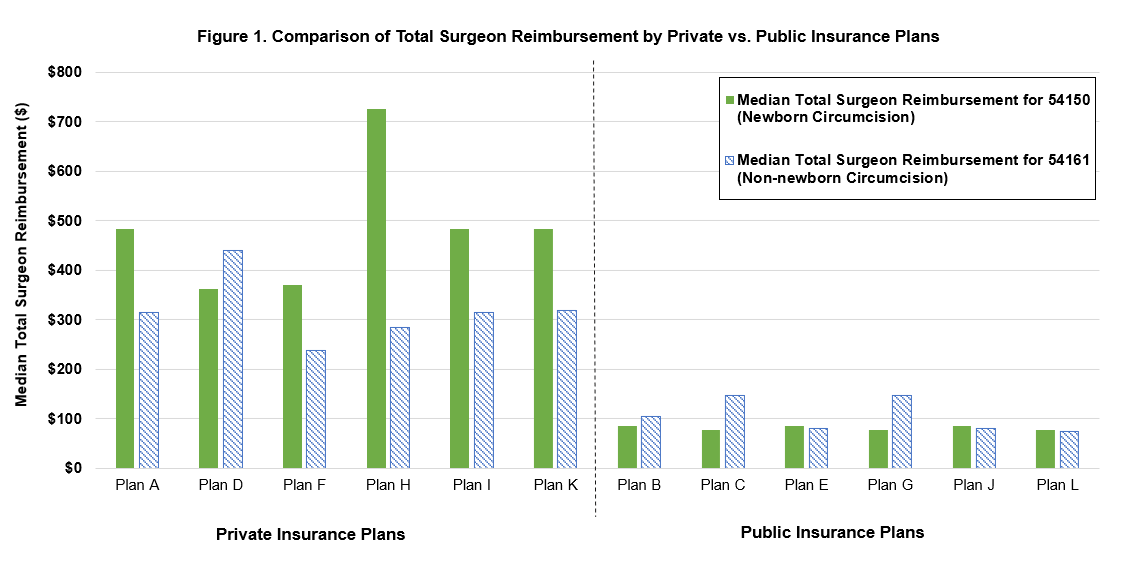Back
Poster, Podium & Video Sessions
Moderated Poster
MP08: Pediatric Urology: Penis & Scrotum
MP08-10: Differential Incentives Created by Private Versus Public Insurance Plan Coverage of Pediatric Circumcision
Friday, May 13, 2022
10:30 AM – 11:45 AM
Location: Room 225
Sophia Kamanzi*, Ryan Walton, Ilina Rosoklija, Lauren Corona, Jane Holl, Emilie Johnson, Chicago, IL
- SK
Poster Presenter(s)
Introduction: Newborn circumcision under local anesthesia is more common among boys with private insurance, while elective operative circumcision (with general anesthesia risks) is more common among publicly insured boys. We hypothesized that differential insurance coverage and reimbursement rates contribute to publicly insured boys having less access to desired newborn circumcision, a healthcare disparity that has been described in prior studies. This study aims to describe public vs private insurance coverage and surgeon reimbursement for circumcisions.
Methods: A survey on circumcision coverage (Current Procedural Terminology codes 54150 and 54161) was given via phone interviews with insurance plan representatives in October 2021. Insurance plans included made up =1% of institutional pediatric urology visits (12 plans total). Characteristics and coverage details for these insurance plans were compared. Billing data were collected for circumcisions at a freestanding pediatric hospital. Total surgeon reimbursement (insurance + patient payment) was compared by plan type using bivariate statistics.
Results: Ten plans (83%) responded (5 private, 5 public). All except 1 reported covering newborn circumcision. Most public plans (80%) covered non-newborn circumcision unrestricted, while all private plans required medical necessity. Median surgeon reimbursement for 54150 (i.e., newborn clamp, local anesthesia) was $484 for private (67% of total charge) and $78 for public plans (11% of total charge), p <0.001. Median surgeon reimbursement for 54161 (i.e., non-newborn circumcision, general anesthesia) was $314 for private (33% of total charge) and $147 for public plans (16% of total charge), p <0.001. Figure 1 shows total surgeon reimbursement by plan.
Conclusions: For newborn circumcision, private insurance plans reimburse physicians significantly more than public plans, both with similar non-restrictive coverage. For non-newborn operative circumcision, private plans reimburse more but have coverage restrictions, and the private vs. public difference is less dramatic. This coverage and reimbursement structure financially incentivizes newborn circumcision for privately insured boys and operative circumcision for publicly insured boys.
Source of Funding: None

Methods: A survey on circumcision coverage (Current Procedural Terminology codes 54150 and 54161) was given via phone interviews with insurance plan representatives in October 2021. Insurance plans included made up =1% of institutional pediatric urology visits (12 plans total). Characteristics and coverage details for these insurance plans were compared. Billing data were collected for circumcisions at a freestanding pediatric hospital. Total surgeon reimbursement (insurance + patient payment) was compared by plan type using bivariate statistics.
Results: Ten plans (83%) responded (5 private, 5 public). All except 1 reported covering newborn circumcision. Most public plans (80%) covered non-newborn circumcision unrestricted, while all private plans required medical necessity. Median surgeon reimbursement for 54150 (i.e., newborn clamp, local anesthesia) was $484 for private (67% of total charge) and $78 for public plans (11% of total charge), p <0.001. Median surgeon reimbursement for 54161 (i.e., non-newborn circumcision, general anesthesia) was $314 for private (33% of total charge) and $147 for public plans (16% of total charge), p <0.001. Figure 1 shows total surgeon reimbursement by plan.
Conclusions: For newborn circumcision, private insurance plans reimburse physicians significantly more than public plans, both with similar non-restrictive coverage. For non-newborn operative circumcision, private plans reimburse more but have coverage restrictions, and the private vs. public difference is less dramatic. This coverage and reimbursement structure financially incentivizes newborn circumcision for privately insured boys and operative circumcision for publicly insured boys.
Source of Funding: None

.jpg)
.jpg)